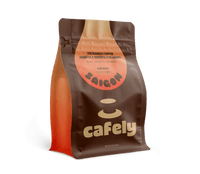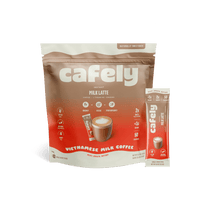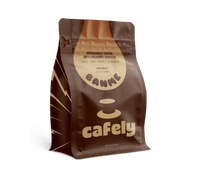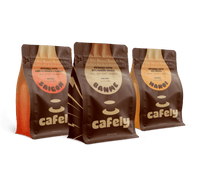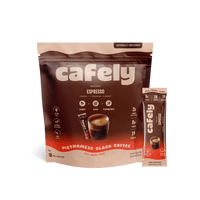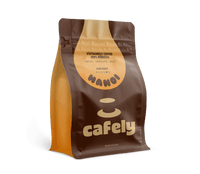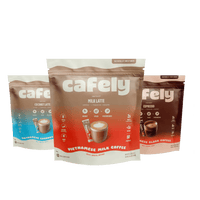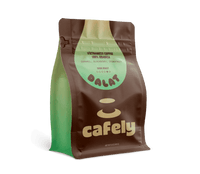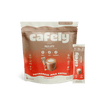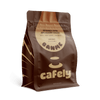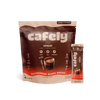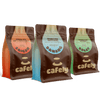Do you rely on a boost of caffeine to wake you up and start your day? Coffee is a morning drink tradition around the world.
Caffeine has a proven ability to boost energy and reduce fatigue. Athletes even find it can enhance performance.
Choosing the right coffee can make a big difference in delivering that boost of energy. Our guide highlights the best coffee options from Cafely to help you stay energized throughout the day. Explore our top picks and learn what factors go into choosing the best coffee for a tasty and powerful drink.
Top Recommendations:
- BanMe Coffee — This robusta blend is known for its high caffeine content and strong flavor, perfect for a powerful energy boost. BanMe is crafted exclusively from 100% shade-grown peaberry robusta beans — a rare find that yields the strongest coffee in the world.
- HaNoi Coffee — Made with 100% Vietnamese robusta beans, HaNoi delivers a bold and full-bodied coffee that provides an intense and long-lasting energy boost.
- SaiGon OG — Strong and flavorful, this bestseller is ideal if you want a robust and invigorating coffee experience. SaiGon brings together the high caffeine of robusta with the smoother flavor of arabica, along with the rich and concentrated flavor of peaberry, a form of robusta bean with a single instead of double seed.
- Vietnamese Coffee 2.0 — 150 mg caffeine per pack (2 shots of espresso) ready in seconds. Available in 3 distinct flavors.
Read on to understand why these are the top recommendations to get the best coffee for energy — and how to brew the perfect cup.
What Makes Coffee So Energizing?

Does coffee give you energy? Yes, because coffee contains caffeine. Caffeine is a naturally occurring central nervous system stimulant and the most used stimulant worldwide. Caffeine, such as in coffee, alleviates fatigue and drowsiness but has other therapeutic benefits, like enhancing athletic performance in endurance sports [1].
Here are some ways caffeine affects your body to increase energy levels:
- Enhances mood and cognition — Some studies show that caffeine enhances mood and cognition [2].
- Regulates neurotransmitters — Caffeine blocks the receptors of a neurotransmitter called adenosine — a central nervous system depressant that promotes sleep and suppresses arousal. That, in turn, increases other neurotransmitters that regulate energy levels, like dopamine [2,3].
- Improves endurance — Researchers in a study on cyclists found that caffeine helped performance. That’s because caffeine reduced their subjective levels of fatigue and increased a measure known as “time to exhaustion [4].”
- Reduces fatigue — Caffeine also improved performance in an examination of consumption during a round of golf. Players also reported increased energy levels and reduced feelings of fatigue. Researchers concluded that caffeine consumed before and during a round of golf “improves golf-specific measures of performance and reduces fatigue in skilled golfers [5].”
Moderation is key, however. Caffeine at high doses can create unwelcome health effects on your cardiovascular, skeletal, and muscular systems [2].
While some caffeine can be beneficial to your health — helping with mood, blood sugar, and metabolism — too much can cause side effects like jitters, feelings of anxiety, insomnia, and other sleeping issues.
Now that you know how coffee can boost your energy, let’s explore the factors that go into selecting coffee with the most caffeine.
How to Brew Coffee for the Most Caffeine
How you make your coffee is the final factor to consider when you’re looking to drink coffee for energy. Some brewing methods extract more caffeine than others.
Let’s start with a summary of how much caffeine is in each of these brewing types:
|
Type of coffee |
Size of cup |
Caffeine per serving |
|
Vietnamese coffee |
2–4 oz |
66–130 mg |
|
Espresso coffee (single shot) |
1–2 shots |
75–150 mg |
|
French press coffee |
8 oz |
100–137 mg |
|
Aeropress coffee |
2–4 oz |
66–130 mg |
|
Pour-over coffee |
8 oz |
90–160 mg |
|
Drip coffee |
8 oz |
65–120 mg |
|
Instant coffee |
8 oz |
80–120 mg |
Here are the top ways to make coffee to maximize the caffeine in your cup.
1. Phin Filter
This small, traditional Vietnamese drip-style brewer sits on your cup and brews a delicious cup of coffee in just minutes. It’s the ideal brewing method to get an energy boost, particularly when you combine it with the strong and bold flavors of Vietnamese robusta coffee.
2. Espresso
An espresso machine forces a small amount of almost-boiling water through finely ground and compacted coffee grounds. To get the most caffeine, you can make a double shot of espresso.
Another way to get the best boost is by using robusta beans and finely grinding them. The longer the water is in contact with the grounds, the more caffeine it contains, too. Espresso can also be the foundation for you to try different coffee drinks, like lattes, cappuccinos, macchiatos, and popular americano coffees.
3. French Press
The plunger pot method also called the French press, can deliver an energy boost in just a few simple steps. Known as immersion-style brewing, French press coffee involves fully immersing the grounds in water and using the plunger to separate the water from the grounds.
4. Aeropress
This quick brewing method is a blend between a French press and an espresso machine, combining immersion and pressure extraction. The Aeropress comes in three sizes and sits on top of your coffee mug.
You can also use the pour-over method or a common drip coffee maker to make your mug of java. Follow the instructions for each brewing method to ensure you are using the correct amount of coffee, heating the water to the proper temperature, and employing the right brewing time to maximize caffeine extraction.
It’s especially important to get the correct water-to-coffee ratio. You might think a bigger cup of coffee is better, but if you use too much water, you’ll end up with less caffeine. Opt for a smaller cup and have two of them, allowing for more of an energy boost in the long run. The more coffee to water that you use will also deliver a cup with more caffeine.
Best Additions to Boost Coffee’s Energy

Does your caffeine-rich coffee need some flavor enhancement? Here are some healthy additives that can boost energy and flavor.
Cocoa
You’ll get a chocolatey flavor plus a boost to your well-being when you add cocoa powder to your coffee. There are a number of reported health benefits that cocoa offers, including improved blood flow and blood supply to your brain. Cocoa also contains caffeine for even more energy-boosting benefits!
Cinnamon
Cinnamon may help your energy level by helping to control blood sugar spikes — which are often followed by crashes that deplete your energy. That could be because cinnamon helps slow down how fast food empties out of your stomach [7]. Cinnamon may also lower blood sugar following meals by blocking digestive enzymes that break down carbs [8].
Sweeteners
If you must add a sweetener to your coffee, look for healthier alternatives than white sugar, which might give you a short-term boost followed by a sugar crash. Honey is an excellent natural sweetener that you probably already have in your kitchen.
Monk fruit sweetener or monk fruit extract is a natural sweetener with zero calories and possible antioxidant properties. Cafely’s instant coffee is blended with a touch of monk fruit if you want to see how you like the taste.
Milk and Milk Alternatives
Some coffee lovers prefer the addition of creamy goodness in their cup, so reach for milk and milk alternatives. Whole milk adds cream and some sweetness, and you can steam or froth it before adding. Sweetened condensed milk is preferred for Vietnamese coffee, including Vietnamese iced coffee. If you’re vegan, you can make your own vegan condensed milk to stir into your coffee for a touch of sweetness.
Butter and Coconut Oil
Butter coffee may also provide extra energy beyond caffeine. What is butter coffee? It’s when you take one cup of coffee, add 1–2 tablespoons of coconut oil and 1–2 tablespoons of unsalted butter, and mix in a blender for 30 seconds to form a latte-like drink.
Since butter coffee has fat, and fat slows digestion, butter coffee is believed to provide extra, longer-lasting energy without a blood sugar crash. Coconut oil contains medium-chain triglycerides (MCTs), which your body quickly breaks and absorbs. MCTs become an instant energy source, or they turn into molecules produced by your liver that boost energy levels over a longer period [9].
How to Get the Most Energizing Coffee Possible

When it comes to brewing the perfect energy-boosting cup of coffee, choosing the right beans is crucial. From the origin of the beans to the roast to the coarseness, here are three top tips to help you choose the best coffee for energy.
1. Brew With Finely Ground Coffee
You have to grind coffee beans before you use them to make coffee, but you have a choice when it comes to the size of the grounds. The coarseness of the final grind impacts the coffee’s strength and flavor, whether you buy pre-ground coffee or grind your own beans at home.
The coarseness also impacts the amount of caffeine that ends up in your cup. The more you grind the beans, the greater the amount of caffeine that gets extracted from the beans. If possible, grind your own beans and make them as fine as possible so you can get the most energy from your coffee.
However, fine grinds work best in specific brewing methods. Finely ground coffee beans require a specific type of brewing method, or the cup of coffee won’t be as good. A fine grind works best in espresso machines and phin filters, for instance.
Grinding your beans at home right before you make coffee preserves the caffeine potency and also ensures you have the freshest coffee possible.
If you purchase pre-ground coffee, get them in the finest grind possible.
Another key to grinding coffee beans is to aim for a consistent grind. As hot water passes over the coffee grounds, it extracts the flavor and caffeine. Having a consistent grind ensures an even extraction of flavor, as the water interacts with all the grounds at the same rate. It also ensures your coffee isn't too bitter or too weak.
2. Choose a Lighter Roast
Coffee’s flavor, aroma, and color develop during roasting, a process that involves drying and roasting the beans.
Coffee is available in light, medium, and dark roasts. You might think a dark roast, with its bolder flavor, has the most caffeine. In fact, light roasts have more caffeine.
When the bean is dark roasted and turns a deep brown color, some of the caffeine burns off. While the flavor of a dark roast may be more robust, the lighter roasts retain more caffeine.
If you want a boost of energy, look for medium to light roasts to maximize the amount of caffeine in your cup. Specific brewing methods work well for lighter roasts, like a French press or a pour-over style of brewing. We’ll explain the different ways to brew coffee later in this article.
3. Use Robusta Beans
The two main types of coffee beans used for brewing coffee are arabica and robusta.
To get the most caffeine bang for your buck, choose robusta beans, which contain higher levels of caffeine than arabica beans. In fact, robusta has almost twice as much caffeine as arabica.
Robusta also has a stronger flavor, sometimes described as bitter, so you can also look for blends if you want a milder flavor. For instance, the Cafely SaiGon OG combines the high caffeine of robusta with the smoother flavor of arabica, along with the rich and concentrated flavor of peaberry, a form of robusta bean.
Another tasty blend is Cafely’s DaNang coffee, made with 50% robusta and 50% arabica beans to give subtle flavors of hazelnut, maple, and citrus.
4. Check the Country of Origin
Where your coffee is grown has an impact on its flavor and — you guessed it — the caffeine level. Soil, climate, and altitude are all factors.
In general, the higher the altitude, the better the beans. Higher altitudes provide warm — but not too hot — growing conditions. Cooler yet ideal temperatures at high altitudes slow down growing, so the bean has more time to mature and develop a full flavor.
Soil temperatures and soil chemistry also have a strong effect on coffee bean quality. Better quality coffee that grows at higher elevations in fertile soil can offer the highest concentrations of caffeine [6].
As a result, beans from certain regions have high caffeine content. Some of the countries that brew the strongest coffee include Ethiopia, Colombia, and Vietnam. Cafely's coffee beans are hand-picked from the lush central highlands of Vietnam.
FAQs: Coffee & Energy
If you want to know more about choosing the best beans for an energy-boosting cup of coffee and how to brew the perfect pot, check out the answers to these frequently asked questions.
1. What Is the Best Coffee for Staying Awake?
The best coffee for staying awake is robusta. Robusta coffee beans contain twice as much caffeine as arabica beans. So robusta-based coffee like Cafely’s BanMe offers high caffeine content ideal for alertness.
2. Can Coffee Really Improve My Energy Levels?
Yes, coffee can improve energy levels due to caffeine’s stimulatory effects on the central nervous system. Caffeine alleviates fatigue and drowsiness by blocking the receptors that promote sleep and increasing neurotransmitters that boost energy levels. For an extra-strong kick, red eye coffee — a bold blend of drip coffee and a shot of espresso — is a popular choice among those needing a serious energy boost.
3. Is It Safe to Drink High-Caffeine Coffee Every Day?
Like anything, moderation is key. Excessive caffeine levels can lead to jitters, anxiety, or problems sleeping. Gauge your own reaction and limit your intake of high-caffeine coffee to avoid negative side effects.
4. How Does the Roast Affect the Caffeine Content in Coffee?
Lighter roasts retain more caffeine than darker roasts since dark roast beans may burn off some caffeine.
5. What Are the Health Risks of Consuming Too Much Caffeine?
The potential health impacts of drinking too much caffeine include insomnia, increased heart rate, jitters, and digestive issues.
6. Can I Drink Coffee Late in the Day?
You can drink coffee late in the day, but depending on how caffeine affects you, it may lead to trouble falling asleep at night. It's best to avoid coffee after 3 p.m. to ensure it does not disrupt your sleep.
7. Are There Any Benefits Of Drinking Organic Coffee?
The biggest benefit of drinking organic coffee is that it has fewer pesticides, which can be better for your health and the environment.
8. How Can I Make My Coffee Taste Less Bitter?
You can make your coffee less bitter by choosing a light roast when you buy your coffee. Make sure you use fresh filtered or bottled water. Follow the steps for the brewing technique you use, and don’t let your coffee sit too long on the warmer. Drink it fresh, and increase the amount of water if you still find it too strong.
9. What Is the Difference Between Arabica and Robusta Coffee Beans?
Arabica is the most widely grown coffee in the world, accounting for about 60% of the world’s coffee production. Coffee made with arabica beans tastes smooth and slightly sweet. Compared to arabica, robusta beans have a higher caffeine content with a flavor that’s more robust, nutty, and slightly bitter.
10. How Do I Know if My Coffee is High Quality?
To make sure you're drinking quality coffee, purchase from a reputable source like a coffee shop or an online coffee production company. Look for beans that are evenly roasted without any visible defects. If you buy pre-ground coffee, make sure you don't buy too much, as the grounds will lose their freshness.
References
- Evans, A. S., Lennemann, N. J., & Coyne, C. B. (2021). BPIFB3 interacts with ARFGAP1 and TMED9 to regulate non-canonical autophagy and RNA virus infection. Journal of cell science, 134(5), jcs251835.
- Alasmari, F. (2020). Caffeine induces neurobehavioral effects through modulating neurotransmitters. Saudi Pharmaceutical Journal, 28(4), 445-451.
- Meeusen, R., Watson, P., Hasegawa, H., Roelands, B., & Piacentini, M. F. (2006). Central fatigue: the serotonin hypothesis and beyond. Sports medicine, 36, 881-909.
- Smirmaul, B. P., de Moraes, A. C., Angius, L., & Marcora, S. M. (2017). Effects of caffeine on neuromuscular fatigue and performance during high-intensity cycling exercise in moderate hypoxia. European journal of applied physiology, 117, 27-38.
- Mumford, P. W., Tribby, A. C., Poole, C. N., Dalbo, V. J., Scanlan, A. T., Moon, J. R., ... & Young, K. C. (2016). Effect of caffeine on golf performance and fatigue during a competitive tournament. Medicine & Science in Sports & Exercise, 48(1), 132-138.
- Getachew, M., Tolassa, K., De Frenne, P., Verheyen, K., Tack, A. J., Hylander, K., ... & Boeckx, P. (2022). The relationship between elevation, soil temperatures, soil chemical characteristics, and green coffee bean quality and biochemistry in southwest Ethiopia. Agronomy for Sustainable Development, 42(4), 61.
- Wang, J., Wang, S., Yang, J., Henning, S. M., Ezzat-Zadeh, Z., Woo, S. L., ... & Li, Z. (2021). Acute effects of cinnamon spice on post-prandial glucose and insulin in normal weight and overweight/obese subjects: a pilot study. Frontiers in nutrition, 7, 619782.
- Hayward, N. J., McDougall, G. J., Farag, S., Allwood, J. W., Austin, C., Campbell, F., ... & Ranawana, V. (2019). Cinnamon shows antidiabetic properties that are species-specific: effects on enzyme activity inhibition and starch digestion. Plant Foods for Human Nutrition, 74(4), 544-552.
- Schönfeld, P., & Wojtczak, L. (2016). Short-and medium-chain fatty acids in energy metabolism: the cellular perspective. Journal of lipid research, 57(6), 943-954.
